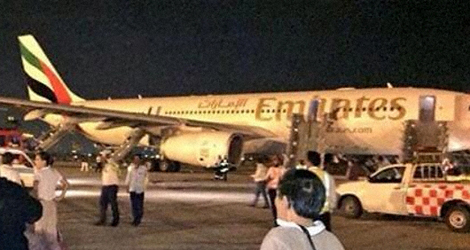On 4 October 2014, Emirates flight EK609 , from Jinnah International Airport (JIAP), Karachi, Pakistan, to Dubai International Airport (OMDB), the United Arab Emirates, with 14 crewmembers and 68 passengers onboard was operated by an Airbus A330 Aircraft, registration A6-EAQ.
As preparations for departure were completed the flight of Emirates flight EK609 crew sensed an odor accompanied by a yellow hydraulic system low pressure indication on the electronic centralized aircraft monitoring (ECAM) system.
The odor was due to hydraulic fluid mist that entered the cabin and cockpit through the airconditioning system. The source of the hydraulic fluid mist was leakage from a fractured hose that provides hydraulic pressure to the rudder yellow system actuator.
The leaking hydraulic fluid entered the auxiliary power unit (APU) of Emirates flight EK609 from where it entered the airconditioning system.
Examination of the hose concluded that the cause of the fracture was, most probably, fatigue failure of the metal braiding, followed by fracture of the hose PTFE core pipe. The mist filled the cockpit and cabin and caused difficulty in breathing, throat discomfort, and eye irritation for some occupants.
In an attempt to determine the source of the mist, which was perceived as smoke, the cabin crew member of Emirates flight EK609 located at the L3 door handed a fire extinguisher and protective breathing equipment (PBE) to the cabin crewmember stationed at door L1A, and after the latter had donned the equipment and pulled the lanyard to activate the PBE oxygen generator, the PBE caught fire.
The crewmember removed the PBE immediately and threw it on the floor next to the L3 door. This caused a localized fire that was suppressed by other crewmembers. Based on initial information, the Commander decided to return the Aircraft to the stand and disembark the passengers and crew using steps.

Emirates flight EK609 – Airbus A330-243 (A6-EAQ)
The Commander of Emirates flight EK609 requested information about the situation in the cabin from the L4 cabin crewmember, who stated that visibility in the cabin was now limited to four rows.
On receiving this information, the Commander decided to order an evacuation while the Aircraft was at its final pushback position. The evacuation of the Aircraft was well-managed with only minor injuries to some of the passengers.
Following the evacuation, the passengers of Emirates flight EK609 stayed close to the Aircraft as they were not given directions as to what to do or where to go. On becoming aware of the evacuation of the Aircraft, ATC did not issue any instruction to halt airside operations, and several aircraft and vehicles continued moving.
The Air Accident Investigation Sector (AAIS) determined that the cause of the dense mist was the failure of a yellow hydraulic system rudder servo hose that allowed leaking hydraulic fluid to enter the APU, become heated and atomized, and then to be fed into the Aircraft airconditioning system. The cause of the hydraulic hose failure was not determined by the Investigation.
The AAIS determined that it is probable that manufacturing defects in the PBE candle caused the candle to ignite abnormally when the cabin crewmember pulled the activation lanyard. A contributing factor to the Incident was that the flight crew were unable to identify the source of the mist/smoke and decided to leave the APU running in case it became necessary to shutdown both engines.
The Air Accident Investigation Sector determines that the causes of the dense mist entering the cabin, and the subsequent PBE fire onboard the EK609 Airbus A330 were:
- The failure of a yellow hydraulic system rudder servo hose that allowed leaking hydraulic fluid to enter the APU where the fluid was heated and atomized and was then fed into the cabin airconditioning system. The cause of the hydraulic hose failure was not determined.
- It is probable that manufacturing defects in the PBE candle caused a vigorous chemical reaction in the candle which resulted in abnormal ignition when the cabin crewmember, who had donned the equipment, pulled the activation lanyard.
Contributing Factor to the Incident As the flight crew were unable to identify the source of the mist/smoke, they decided to leave the APU running in case it became necessary to shutdown both engines, but they did not close the APU bleed as required by the SMOKE/FUMES/AVNCS SMOKE checklist.
The result of this decision was that hydraulic fluid mist continued to enter the cabin.
This decision was taken without having positively identified the sources of the smoke/mist.
Download Report


0 Comments